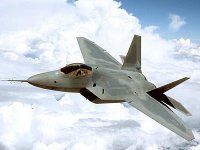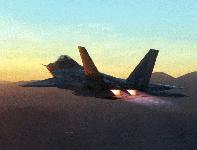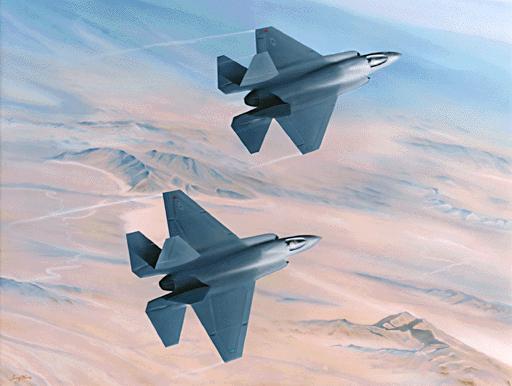|
|
|


*Dan's F-22 Raptor Fansite*
| Site Navigation |
|---|
| F-22 Photo Gallery |
| Raptor Specifications |
| The F119 Turbojet Engine |
| Weapons and Armaments |
| Links of Intereast |
|---|
| http://www.f-22raptor.com |
| http://www.f22fighter.com |
| http://www.fa22raptor.com |
| http://www.f22-raptor.com |
*The History Behind the F-22*
In the 1970s - 1980s the United states military began its "Advanced Tactical Fighter" (ATF) program to design a superior aircraft in order to compete with soviet fighters such as the Flanker, Fulcrum, and next generation MiGs. Because of the soviet fighter's ability to out maneuver and out preform the US F-15 Eagle fighter in 1 on 1 dog fights, the United States Airforce decided to fund a orginization and research team to build and engineer the new generation of air superiority fighter aircraft.
The main objective for this new "super fighter" was to create a balanced, light weight aircraft without sacrificing recovery, a improved stealth system to make the aircraft invisible to enemy rader, and safety features to ensure the pilot a safe ride home. The government added requirements and attributes that must be used in the building of the next gen fighter. Light-weight alloys, state-of-the-art navigation and HUD (heads up display), vast support for numerous ballistics and weaponry, compatibility to almost every missile and bomb, High-end propulsion systems, advanced flight controls, and most importantly, Stealth Technology, were all requirements to be used and embedded into the worlds most superior fighter. This after all, was to replace the F-15 Eagles and F-16 Falcons which were currently in service and make them obsulete and in the 21st century. With all these factors in mind, the military started to get to work.
In 1986, Lockheed / Boeing / General Dynamics and Northrop / McDonnell-Douglas were each given a contract by the RFP to design the next gen fighter over a 50 month period to see which of the two contractors would be given the funding to maintain the program. The due date for the final product demonstration was scheduled to be around mid 1989. With Lockheed / Boeing / General Dynamics demonstarting their YF-22 prototype and Northrop / McDonnell-Douglas showing of their YF-23 Prototype, the competition was on. Through a series of tests, the two fighters were pushed to the limit in head to head dog fights, accuracy tests, and speed runs until 1 fighter would remain superior over the other. The F-22 was chosen for its exceptional speed, agility, and success of its prototype and won the contract of $86.6 Million dollars to build an estimated 648 aircraft and to continue its research on the F-22.

During the 1990s, Lockheed / Boeing / General Dynamics ran numerous test runs and simulated dog fights to perfect the F-22 to try to make it as error free and stealthy as possible. In 1997, the EMD (engineering and Manufacturing development) program launched the first succesful F-22 demonstration which shocked the military audience. A series of events and tests included 1 on 1 dog fights against F-15s and F-16s, a speed and velocity test, and finally a stealth test. The Raptor excelled in every challenge thrown at it. What most of the military staff were amazed at was how stealthy the aircraft was at high altitude flying. It was almost invisible on radar while flying at a low altitude and could barely be seen flying at a higher altitude. Following the intial prefomance tests was a series of weapon and accuracy testing. Missiles on the F-22 are located inside internal bays around the bottom of the plane. Having missiles in the inside of the plane rather than the outside on the wing dramatically increases its stealth rating. When a missile is fired, the Raptor's bay doors open and a titanium - based arm which supports the missile is extended. Once the missle is fired, the arm retracts and the bay doors shut, thus the phrase "Beware of raptors with open doors".
The assembly for the first production Raptor began in march 2001. The assembly of the aircraft took about 11 months to complete. Once the airframe was completed, its was shipped to the Marietta Ga. facitlity to install the twin F119 Pratt/Whitney engines which powered the Raptor. The final test runs of the production model was a success. The United States Airforce plans to to welcome the raptor fully into service in 2007 or early 2008. The military is also planning on making a varient of the Raptor for every branch of the military. The X-35 project is already under way in creating a aircraft for each the Navy, Marines, Army, and Coast Gaurd, each with unique features such as short take off ability for Navy and Coast Gaurd Aircraft Carriers and all terrain capable fighter for the Army and Marines. The X-35 will borrow many aspects from the F-22 Raptor such as its Stealth technology, armament capablities, and advanced flight dynamics. The X-35 is listed to come into service around 2011. With the future of aeronautics looking better and better every year, we can count on the Raptor for being "The Fighter of the 21st Century".
*The Future of Aviation. Below, a picture of 2 ideal models for the X-35.*

- If you have any questions or concerns or have any ideas on how to better the site, please email me at danlob@neo.rr.com